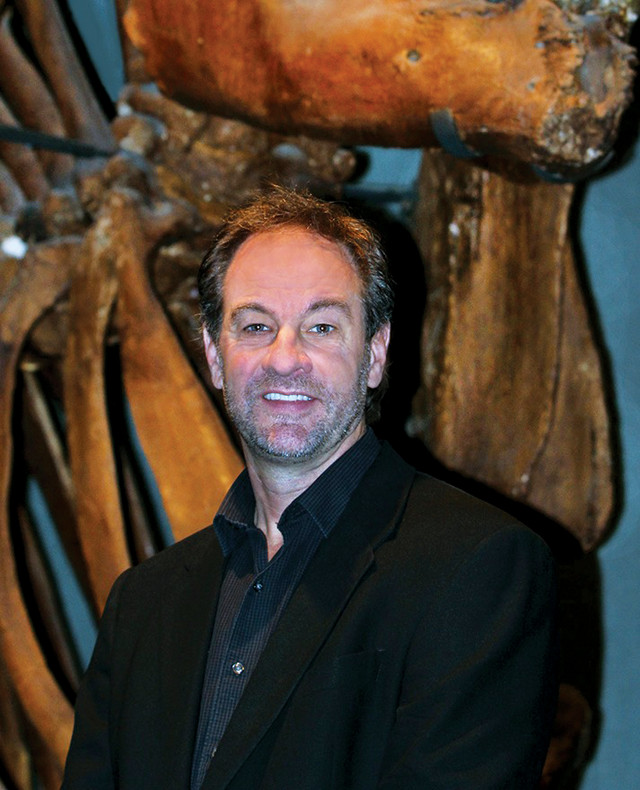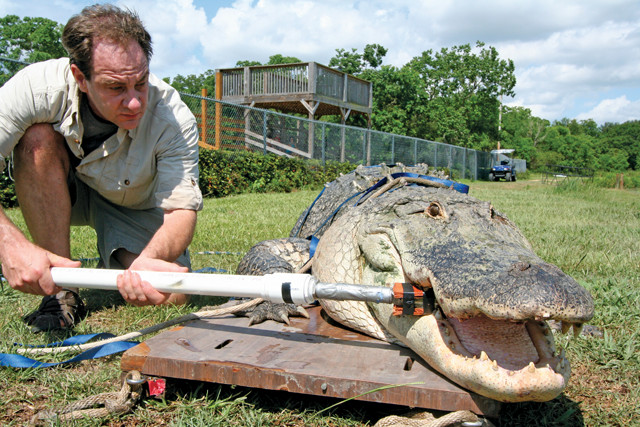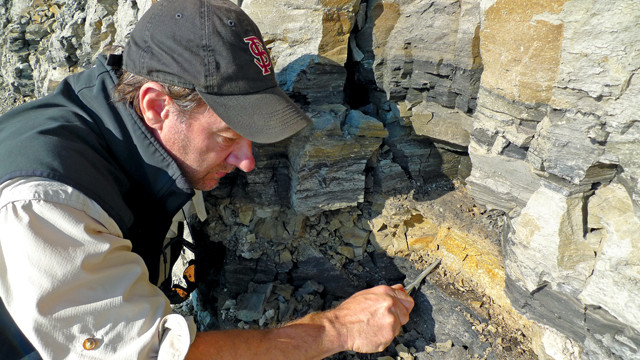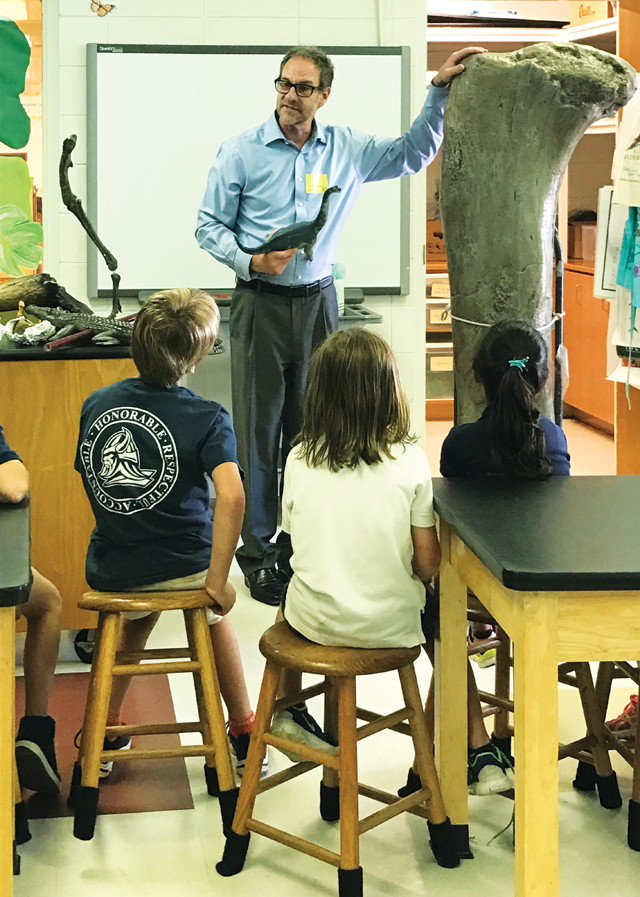
by Bethany Augliere Monday, September 18, 2017

Gregory Erickson is a professor of anatomy and vertebrate paleobiology at Florida State University in Tallahassee, Fla. Credit: Gregory Erickson.
As an undergraduate at the University of Washington, Gregory Erickson wasn’t sure what he wanted to do. He started out as an engineering major, then dabbled with getting a degree in wildlife management. In 1986, having taken numerous science courses, he happened to compare notes with his best friend, a geology major, and realized he was just a few courses shy of obtaining a geology degree himself. Eager to finish college, Erickson signed up for a class in vertebrate paleontology focusing on dinosaurs — a decision that ultimately changed his life.
After Erickson earned the second-highest grade out of 500 students in the class, his professor invited him to join a field expedition in Montana to collect dinosaurs for the university museum. The professor, impressed with Erickson’s ability to visualize fossils as living animals, encouraged him to go into paleontology. “In many ways, the field found me,” Erickson says.
Erickson moved on to Montana State University in Bozeman for graduate school, pursuing a master’s degree in biology. In his research, he discovered daily-forming growth lines in dinosaur teeth, similar to those in modern mammals and crocodilians. The work netted him the Alfred Sherwood Romer Prize for the best student presentation at the 1991 Society of Vertebrate Paleontology annual meeting. He went on to get his doctorate in integrative biology at the University of California, Berkeley, and subsequently conducted post-doctoral research in biomechanical engineering at Stanford University and ecology and evolutionary biology at Brown University.
Today, Erickson is a professor of anatomy and vertebrate paleobiology at Florida State University (FSU) in Tallahassee. He combines his expertise in paleontology, engineering, anatomy and zoology to study teeth and bones to explore questions about the growth rates, feeding ecology and biomechanics of both extinct and living reptiles. He recently co-discovered that the bite force of Tyrannosaurus rex was 3,629 kilograms — the equivalent of being crushed by three small cars.
Erickson has received numerous awards for both his innovative research and his teaching. He’s also been part of more than 135 science documentaries, including hosting “Hunter & Hunted,” a National Geographic Channel series that focused on human interactions with predatory animals.
Erickson recently sat down with EARTH to discuss the big questions in dinosaur biology, his philosophy on communicating science to the public, and how he got started working in television.
BA: Were you interested in science as a child?__
GE: Yes, I grew up around wildlife and science. I loved dinosaurs, just like any little kid, and I had a rock and fossil collection. When I was very young, my family even had a pet polar bear and bobcat for a short period.

Using modern alligators as an analogue, Erickson determined that the 8-metric-ton SuperCroc (Sarcosuchus imperator), which lived about 110 million years ago during the Middle Cretaceous, had a bite force of about 8,165 kilograms, more than double that of a Tyrannosaurus rex. Credit: Gregory Erickson.
BA: Did you just say you had a pet polar__ bear?__
GE: My father was a wildlife biologist and the regional director for the Alaska Department of Fish and Game in Anchorage. He worked with a chemist and discovered how it was possible to raise orphaned bear cubs by feeding them cow’s milk with the addition of the right enzymes. So, he’d raise bear cubs from mothers that had been killed in the wild, or from captive animals that rejected their young. We had a polar bear named Snowflake at our house for about six months until it destroyed the kitchen and my mom said we had to find it a new home. It eventually went to a zoo in Canada.
BA: How did you get started as a__ paleontologist?__
GE: I was a construction worker for about a year after graduating college. The money was good, but I knew it wasn’t what I wanted to do for the rest of my life. One day I got tired of getting rained on in Seattle, took to heart what my [undergraduate] paleontology professor had said and signed up for the GRE. I was accepted into the biology graduate program at Montana State University in Bozeman, with Jack Horner as my advisor. Jack is the famous dinosaur paleontologist after whom the character Alan Grant from “Jurassic Park” was modeled. Jack — jokingly, I think — intimated that he accepted me less for my ideas and more because I knew how to use a shovel.
BA: Why were you interested in teeth__ specifically?__
GE: As a kid, I used to help my dad catch bears. He would age them using cementum rings in their teeth, and he taught me the technique. Then when I was an undergraduate, I got a job working up in Alaska in the summers of 1984 and 1985, studying salmon runs in rivers and working from a fishing research boat in Bristol Bay. We’d catch salmon and age them from otoliths — their ear bones. Studying growth lines in teeth hadn’t been done much in paleontology. So that’s what I wanted to study at Jack’s lab, in dinosaurs, specifically. I guess I’ve become a dino dentist; I just have this obsession with teeth!
BA: You aged Sue, the__ T. rex at the Field Museum in Chicago, using growth lines in the skeleton. What was that experience__ like?__
GE: Doing research on rare fossils feels like dancing on a high wire. You’ve talked somebody into letting you do something that is kind of risky, so it has to pay off. I knew, in theory, it could work, but if I screwed up, my reputation was on the line. I’d be famous for failure — it’d be my Waterloo.

Erickson, seen here digging into ash layers (top) and rappelling down a cliff (bottom) in search of fossils, is co-director of the Arctic Paleontological Research Consortium, which studies how dinosaurs lived at high latitudes. Credit: both: Gregory Erickson.
BA: At first, nobody thought you could age a__ T. rex, right?__
GE: People thought you could never age T. rex because their bones get hollow as they grow older; the bones are also remodeled during life, so you can’t see the growth lines anymore. It is sort of like trying to age a tree that has been hollowed out and also eaten up by wood-boring beetles.
I went to visit the Field Museum, and as I was looking at Sue and other tyrannosaurs, I realized that some of the solid bones, like the pubis of the hip bone and the fibula, on the side of the shin, had all of the growth lines intact. I asked the Field Museum if I could cut up some of these bones that hadn’t been used in the mount. They stewed about it for awhile, then finally said I could do it. That’s how I got ahold of the $8.36-million dinosaur. Ultimately, I aged Sue at 28.
BA: Was her age__ surprising?__
GE: When I embarked on this research, no one really knew how long giant dinosaurs lived. Sue is the largest-known T. rex and is really beat up, so people thought she could be anywhere from 100 to 200 years old. I was stunned to find she was so young. I often say T. rex was the James Dean of dinosaurs; they lived fast and died young.
BA: You’ve been involved in a lot of documentaries and even hosted some shows. How did that__ begin?__
GE: When I was getting settled as a new professor, around 2000, I got a call from a producer at National Geographic who told me they were working on a film about a 110-million-year-old crocodile, called SuperCroc (Sarcosuchus imperator), the largest member of the crocodile family. They had a lot of footage of the scientist digging up the skeleton, but needed more material for the two-hour special. The producer asked if I could figure out how to estimate the bite force, which had never been done before. I said, “Yes, and the way to do it would be through the testing of bite forces in living crocodilians.” But I told them I couldn’t do it. I was a new professor and didn’t want to appear like I wasn’t serious about getting tenure by running off and doing this “cowboy science.” I also mentioned that I didn’t have a grant, which is required to advance in academia. The producer told me that National Geographic has grants [available]. I received the one-page application, submitted it, and heard back in a day that it was approved. My first grant — I wish they all were so easy!
I did the research, and after that film, another producer from National Geographic called me up, said she liked what I said and how I said it, and asked if I would host “Hunter & Hunted.” I was able to travel to exotic places like Komodo Island and Kodiak Island. It was really exciting. Since then, I’ve done about 135 films.
I never expected TV to be part of my career. And I have to admit, when I first did the show, I didn’t tell any colleagues. I was flying up to D.C. on weekends to film the episodes. I was worried about tenure, and also what my professional colleagues would think about me being a TV presenter. Actually, a number have talked to me about it since, and said they wish there were more professional voices for science on TV.

Erickson during a field research expedition in Mongolia. Credit: Gregory Erickson.
BA: How do you determine the bite force of an extinct giant__ crocodile?__
GE: For that work, I teamed up with engineering colleagues to design bite force meters specifically for use on crocodilians. Unfortunately, we had only six weeks to get them ready for the film, so the race was on! We first tested a growth series of alligators at the St. Augustine Alligator Farm Zoological Park, lassoing them, and holding or strapping them down. They were more than happy to crush down on the meter. We recorded a 964-kilogram bite force for a large adult alligator — the highest bite force ever measured in an animal at that time. We then caught wild alligators to compare them to captive ones, and found they have the same bite force. That gave me a green light to use captive animals as models for [species’ behavior] in the wild. When I wanted to do other species of crocodilian, my team went to Australia and tested some 5-meter crocodiles and got a world-record bite force of 1,678 kilograms. Ultimately, we determined that the SuperCroc had a bite force of about 8,165 kilograms. That’s like setting a semi-trailer truck on top of those jaws — crazy.
BA: What are you working on__ now?__
GE: I’m co-director of the Arctic Paleontological Research Consortium with Pat Druckenmiller, curator of earth science at the University of Alaska’s Museum of the North in Fairbanks. We’re trying to unlock the mystery of how dinosaurs lived at high latitudes. Although the world was warmer then, there still would’ve been five to six months of complete darkness and it would have snowed on them. In Alaska today, it’s rainy and cold, and the bones we find in the Arctic are actually in permafrost. It is rough fieldwork. So, just like we are dealing with rough conditions up there, so were the dinosaurs.
It’s like a lost world in the Arctic — almost every dinosaur [we find] is a new species. We put out a theory a few years ago that the Arctic dinosaurs were a cold-adapted group and that’s why they are all different from other parts of the continent. We never find turtles or crocodiles — no ectotherms. This supports the idea of dinosaur warm-bloodedness. No one realized there was a cold-adapted fauna of dinosaurs, and that’s really exciting.
Also, we recently began exploring Denali National Park. Last year, we found thousands of dinosaur tracks, including from raptors. We also found the first dinosaur bones in the park. We’re trying to learn more about the population biology.

Erickson often speaks to elementary school groups and has participated in more than 135 science documentaries, including hosting "Hunter & Hunted," a National Geographic Channel series that focused on human interactions with predatory animals. Credit: Gregory Erickson.
BA: What are some of the big unanswered questions in dinosaur__ biology?__
GE: We’ve been stymied trying to figure out how to sex dinosaurs because we can’t do it from just looking at skeletons. There have been a few theories that didn’t pan out or are still on trial. A few years ago, a paper came out saying you could look at the tailbone to determine sex, which would be shorter in females relative to males, so she could pass the eggs. But I did a study with alligators, showing that that did not work; males and females showed the same variation. So, that’s one of the biggest mysteries — not knowing the sex of an animal.
The second biggest question is how they got so big. And the third is, why aren’t they around anymore? I’ve spent my career trying to figure out anything I can learn from bones and teeth, and what they can tell you about biology. I always try to find something in a modern animal that I can carry over to paleontology, like the replacement rates for teeth or how they grew from growth lines in their bones. It’s like forensic science: We are very limited by what material is in front of us. Many questions are intractable given what we have to work with.
BA: You give a lot of talks to elementary school students. Why is communicating science, particularly to kids, important to__ you?__
GE: Dinosaurs are often children’s first introduction into science, and it’s actually an important field in that sense. It’s dinosaur paleontology’s most redeeming quality, in my opinion. When I talk to kids, I don’t tell them that we already know everything about dinosaurs. The problem with that message is you’re telling kids that everything has been done and there is nothing for a kid to do if they grow up and want to be a paleontologist. The bottom line is that we know hardly anything about dinosaurs relative to animals that live today.
What I try to do when talking to kids is get them excited about the scientific method. I teach them how we figured something out. I find that kids are more excited about how we learned something, rather than what we learned. I think it is a good life skill for young people to ask for the data in support of things they are told.
© 2008-2021. All rights reserved. Any copying, redistribution or retransmission of any of the contents of this service without the expressed written permission of the American Geosciences Institute is expressly prohibited. Click here for all copyright requests.